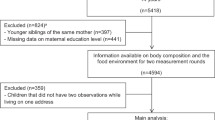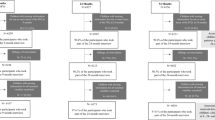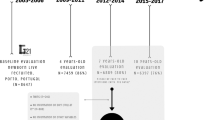Abstract
OBJECTIVE: To describe associations between eating behaviors, dietary intake, physical activity, attitudes toward diet and health, sociodemographic variables and body mass index (BMI) among women and children, and differences by household income.
DESIGN: Data from the 1994–1996 Continuing Survey of Food Intakes by Individuals (CSFII) and the Diet and Health Knowledge Survey (DHKS) were examined using multivariate regression to estimate the associations between BMI and behavioral and environmental variables among women and children.
SUBJECTS: CSFII 1994–1996 is representative of the US population. DHKS surveyed CSFII respondents 20 y of age and over. Our samples consisted of 2419 adult women and 1651 school-age children.
MEASUREMENTS: CSFII respondents reported 24 h recalls of all food intakes on 2 nonconsecutive days and their personal and household characteristics, including self-reported height and weight. DHKS collected data on knowledge and attitudes toward dietary guidance and health from CSFII adult respondents.
RESULTS: Significant correlations between women's BMI and age, race, dietary patterns, TV watching, and smoking was observed among women from both low- and high-income households. Beverage consumption, eating out, the importance of maintaining healthy weight, and exercise were correlated with BMI only among women from high-income households. Among children, age, race, income, and mother's BMI were significantly correlated with child BMI.
CONCLUSIONS: Among women, the associations between some behavioral and environmental factors and BMI differ by household income. Intervention programs need to target specific eating and physical activity behaviors to promote a healthy body weight.
This is a preview of subscription content, access via your institution
Access options
Subscribe to this journal
Receive 12 print issues and online access
$259.00 per year
only $21.58 per issue
Buy this article
- Purchase on Springer Link
- Instant access to full article PDF
Prices may be subject to local taxes which are calculated during checkout
Similar content being viewed by others
References
Sobal J, Stunkard AJ . Socioeconomic status and obesity: a review of the literature. Psychol Bull 1989; 105: 260–275.
Flegal KM, Harlan WR, Landis JR . Secular trends in body mass index and skinfold thickness with socioeconomic factors in young adult women. Am J Clin Nutr 1988a; 48: 535–543.
Flegal KM, Harlan WR, Landis JR . Secular trends in body mass index and skinfold thickness with socioeconomic factors in young adult men. Am J Clin Nutr 1988b; 48: 544–551.
Jeffery RW, French SA, Forster JL, Spry VM . Socioeconomic status differences in health behaviors related to obesity: the Healthy Worker Project. Int J Obes 1991; 15: 689–696.
Jeffery RW, French, SA . Socioeconomic status and weight control practices among 20–45 year old women. Am J Public Health 1996; 86: 1005–1010.
Jeffery RW, French SA . Epidemic obesity in the United States: are fast foods and television viewing contributing? Am J Public Health 1998; 88: 277–280.
French SA, Harnack L, Jeffery RW . Fast food restaurant use among women in the pound of prevention study: dietary, behavioral and demographic correlates. Int J Obes 2000; 24: 1353–1359.
Gordon-Larsen P, Adair LS, Popkin BM . The relationship of ethnicity, socioeconomic factors, and overweight in US adolescents. Obes Res 2003; 11: 121–129.
Strauss RS, Pollack HA . Epidemic increases in childhood overweight, 1986–1998. J Am Med Assoc 2001; 286: 2845–2848.
Trost SG, Kerr LM, Ward DS, Pate RR . Physical activity and determinants of physical activity in obese and non-obese children. Int J Obes 2001; 25: 822–829.
Sallis JF, Alcaraz JE, McKenzie TL, Hovell MF . Predictors of change in children's physical activity over 20 months: variations by gender and level of adiposity. Am J Prev Med 1999; 16: 222–229.
Crespo CJ, Smit E, Troiano RP, Bartlett SJ, Macera CA, Andersen RE . Television watching, energy intake, and obesity in US children: results from the Third National Health and Nutrition Examination Survey, 1988–1994. Arch Pediatr Adolesc Med 2001; 155: 360–365.
Jahns L, Siega-Riz AM, Popkin BM . The increasing prevalence of snacking among US children from 1977 to 1996. J Pediatr 2001; 138: 493–498.
Kant AK . Reported consumption of low-nutrient–density foods by American children and adolescents: nutritional and health correlates, NHANES III, 1988 to 1994. Arch Pediatr Adolesc Med 2003; 157: 789–796.
French SA, Story M, Neumark-Sztainer D, Fulkerson JA, Hannan P . Fast food restaurant use among adolescents: associations with nutrient intake, food choices and behavioral and psychosocial variables. Int J Obes 2001; 25: 1823–1833.
US Department of Agriculture, Agricultural Research Service. Continuing survey of food intakes by individuals 1994–96, 1998. CD-ROM. Available from National Technical Information Service, Springfield, VA, 2000.
Shah BV, Barnwell BG, Bieler GS . SUDAAN User's Manual, Release 7.5. Research Triangle Institute: Research Triangle Park, NC; 1997.
Kuchler F, Lin BH . The influence of individual choices and attitudes on adiposity. Int J Obes 2002; 26: 1–6.
Binkley JK, Eales J, Jekanowski M . The relation between dietary change and rising US obesity. Int J Obes 2000; 24: 1032–1039.
Fisher JO, Mitchell DC, Smiciklas-Wright H, Birch LL . Parental influences on young girls' fruit and vegetable, micronutrient, and fat intakes. J Am Diet Assoc 2002; 102: 58–64.
Davison KK, Birch LL . Obesigenic families: parents' physical activity and dietary intake patterns predict girls' risk of overweight. Int J Obes 2002; 26: 1186–1193.
Fogelholm M, Nuutinen O, Pasanen M, Myohanen E, Saatela T . Parent–child relationship of physical activity patterns and obesity. Int J Obes 1999; 23: 1262–1268.
Wardle J, Guthrie C, Sandersen S, Birch L, Plomin R . Food and activity preferences in children of lean and obese parents. Int J Obes 2001; 25: 971–977.
Birch LL, Davison KK . Family environmental factors influencing the developing behavioral controls of food intake and childhood overweight. Pediatr Clin of N Am 2001; 48: 893–907.
Acknowledgements
Research for this paper was supported by USDA-ERS Cooperative Agreement No. 43-3AEM-9-80119.
Author information
Authors and Affiliations
Corresponding author
Rights and permissions
About this article
Cite this article
Lin, B., Huang, C. & French, S. Factors associated with women's and children's body mass indices by income status. Int J Obes 28, 536–542 (2004). https://doi.org/10.1038/sj.ijo.0802604
Received:
Revised:
Accepted:
Published:
Issue Date:
DOI: https://doi.org/10.1038/sj.ijo.0802604
Keywords
This article is cited by
-
The relationship between yogurt consumption, body weight, and metabolic profiles in youth with a familial predisposition to obesity
European Journal of Clinical Nutrition (2019)
-
Lifestyles and socio-cultural factors among children aged 6–8 years from five Italian towns: the MAPEC_LIFE study cohort
BMC Public Health (2017)
-
Evaluation of eating habits and lifestyle in patients with obesity before and after bariatric surgery: a single Italian center experience
SpringerPlus (2016)
-
Gendered Analyses of Nutrient Deficiencies Among the Elderly
Journal of Family and Economic Issues (2011)
-
Parental Employment, Shared Parent–Child Activities and Childhood Obesity
Journal of Family and Economic Issues (2011)



